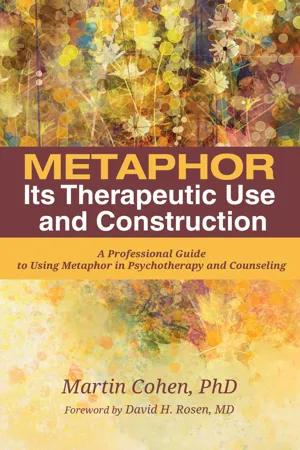![]()
1
Understanding Metaphor
Metaphor is both important and odd—its importance odd and its oddity important.
—Nelson Goodman, Language of Art
As philosophy grows more abstract we think increasingly by means of metaphors that we profess not to be relying on.
—I. A. Richards, Life and Work
Each story conveys a different view of reality and represents a special way of seeing.
—Donald A. Schon, “Generative Metaphor”
A basic aim of the physical and social sciences is to find general explanations of natural events; usually such explanations are called theories. The field of metaphor is no different in its efforts to search out not just the meaning of metaphor, but also a theory that will help to explain this multi–faceted phenomena. Over time, academicians have developed, criticized, and expanded theories of metaphor, what Kövecses (2002, p. xiii) calls the “cognitive linguistic study of metaphor”. They regard metaphor as an important part of life, discourse and learning, and developed theories to more completely explain this phenomenon (see especially Kovecses (2nd ed.), Reynolds and Schwartz 1983, Lakeoff and Johnson 1978, Black 1962, Tourangeau and Sternberg 1982, Torneke 2017).
Innumerable explanations of metaphor come from Aristotle—“Metaphor, is by far the most important thing to master”—to Frost, “All thinking is metaphorical.” I have been selective and diligently tried to choose the works that best illuminate the subject. Let’s begin with a useful review of the understanding of metaphor.
According to Tourangeau and Sternberg (1982), the metaphor is a comparison in which one term (the tenor or subject of the comparison) is asserted to bare a partial resemblance (the ground of the comparison) to something else (the vehicle), to sustain a literal comparison. Put more simply, their comparison theory asserts that metaphorical utterances involve a comparison or similarity between two or more objects. For example, the metaphor, “David is a lion in battle,” compares two figures of unlike nature. Yet in some respect they share similar characteristics. Both are courageous; both fight ferociously and are unconquerable in battle. This thing to which the first object is compared is to be understood in some “transferred” sense. In that sense, David is a lion.
Many authorities advance the notion that the use of metaphor can generate new insights and provide new perspectives. The following examples may suffice to support this contention. Ortony (1975, p. 45) argues for their long tradition as teaching/learning devices:
N. L. Smith (1981, p. 25) concludes that “the utility of metaphors can be viewed as fully established as a heuristic device: a teaching/learning method which encourages a person to discover for him or herself solutions to their life experiences. What has not been established or developed is a comprehensible and employable methodology for utilizing and constructing therapeutic metaphors.”
Burke (1945, pp. 503-504) emphasizes the metaphor as an especially good technique for providing perspective.
Wallace (1982, p. 32) describes the magical quality of metaphor: “Metaphors work in bewildering ways and do a variety of jobs, sometimes so completely that no conscious analysis can follow them. They may illustrate, explain, emphasize, heighten, communicate information or ideas, or carry a tome, feeling or attitude.”
Kopp (1971, p. 7) addresses the old philosophical question, “How do we know?” He answers the “how” by “knowing (the world) metaphorically.” He explains that we “depend on an intuitive grasp of situations, in which we are open to the symbolic dimensions of experience, opened to the multiple meanings that may all coexist, giving extra shades of meaning to each other.”
To give us a more lyrical look at metaphor, writing on the metaphors and parables of gurus, Kopp (1972, pp. 1718) defines metaphor as
The above examples are aimed to orient and acquaint you with the most acceptable—and, perhaps, most popular—theories of metaphor. It appears from a review of the literature that the foundation of metaphoric understanding is grounded in, or at least touches deeply upon, social, philosophical, and linguistic patterns of society, as well as the psychological domain. This being the case, familiarity with these foundations can be helpful to you as a clinician to fully incorporate a working understanding of metaphorical intervention into your therapy process.
![]()
2
Therapeutic Metaphor
A Special Use of Language
Language is vitally metaphorical.
—Shelley, “A Defense of Poetry”
The most fruitful and modern criticism is a rediscovery and recovery of the importance of metaphor.
—Clench Brooks, Irony as a Principle of Structure
All our truth, or all but a few fragments, is won by metaphor.
—C. S. Lewis, Selected Literary Essays
Metaphor, as a therapeutic tool, is a concept borrowed from many ancient and modern disciplines whose practitioners have pondered its meaning, use, and contribution for centuries. While philosophers have been speculating about the nature of metaphor since at least the time of Aristotle, the psychotherapeutic community only recently began to seriously reinvestigate the subject matter. An increasing amount of research and investigation has been conducted since the late 1980s in an attempt to define metaphor, determine its function, locate its academic domain and articulate its construction.
Although it happens that any meaning can be expressed precisely and accurately in a direct way, as a function of the communicator’s abilities, I believe that once the same message is communicated metaphorically, we are dealing in another dimension. To illustrate this point, I propose two descriptions of a person accepting a bribe. The first is a fairly clear and articulate expression of a direct communication. The second produces equality that brings the listener into that new dimension.
Something happens to transform the meaning and it becomes understood, sometimes dramatically, differently. Differently, in that a feeling, emotion, and an affective state are produced that influences one’s outlook or relatedness to the issue being considered. The metaphor engenders this affective state that joins with the cognitive component. The client thus obtains an alternate frame of referenc...
